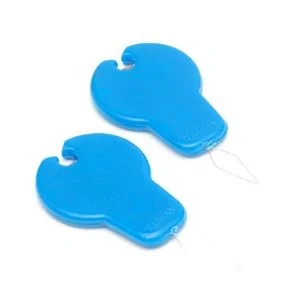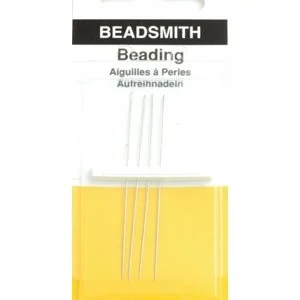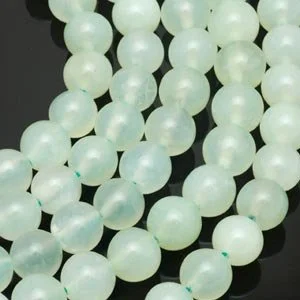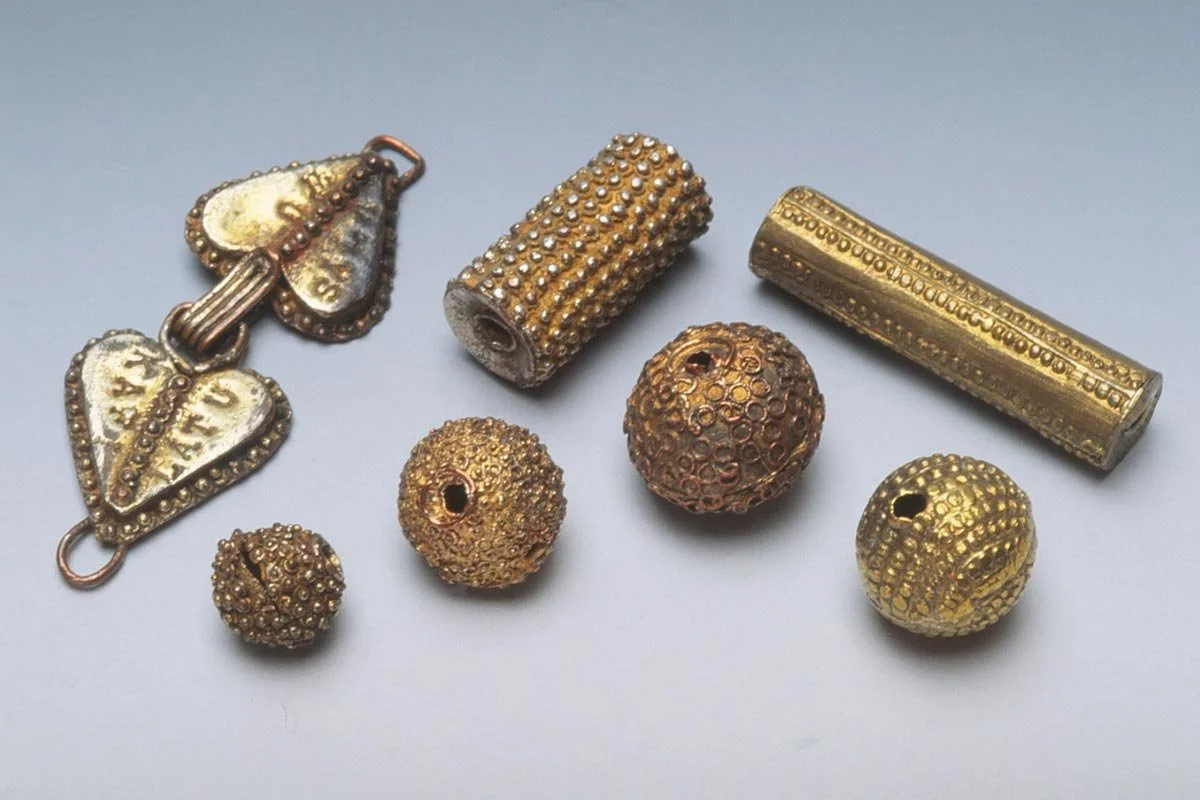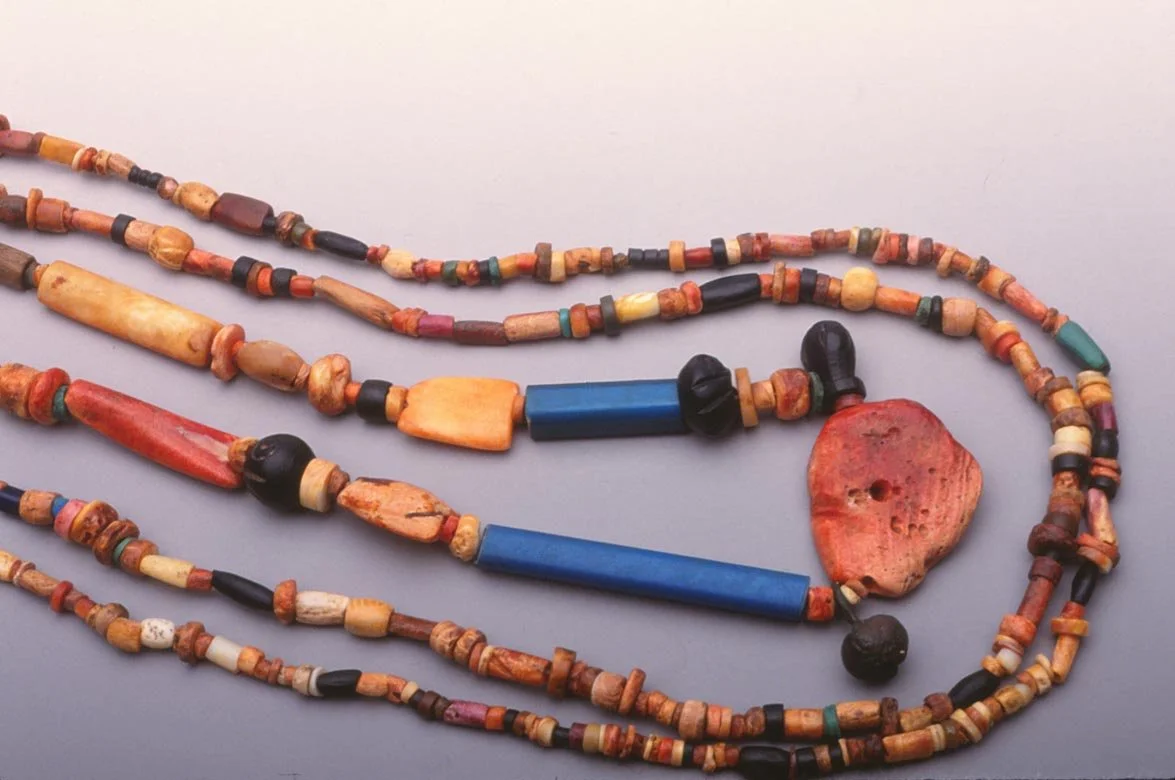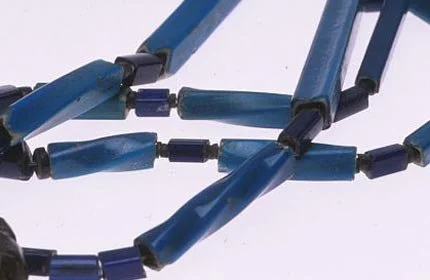Bead Dictionary Letter N
Introduction
In the late 1990s, Penny Diamanti, Joyce Diamanti and Robert K. Liu started working on a Bead Dictionary. Around 2009, after much work by the Diamantis, the Bead Dictionary was posted on the Beadazzled website. Through the years, additions were made by Beadazzled. In the summer of 2018, when the Washington DC Beadazzled store and its website closed, the Bead Dictionary was offered to Ornament. This is a unique resource, especially rich for information on beads of ethnographic and ancient origins. As Ornament has only a staff of three, we are slowly reposting it on our website, updating or expanding some of the entries and are adding search features, links and references as time permits. The Bead Dictionary covers primarily beads and other perforated ornaments, but also tools and materials used by those who make jewelry utilizing beads. Photographs from the Ornament archives are being added, as well as new images taken expressly for the Bead Dictionary and others are being brought up to current standards, as many of these images are almost 30 years old. Original photography was by Robert K. Liu, while Cas Webber did additional photos for Beadazzled, noted in the captions as RKL or CW, after first captions.
This Dictionary of Beads is a labor of love and a work in progress. We welcome your comments and suggestions through the Contact link. To navigate, select from the visual index above to jump to the letter you want in the Dictionary, but give the page a little time to load first. To get back to the top and select another letter use the arrow button. We are continuously adding to the Dictionary, so check back often.
To search for keywords in Dictionary headings, use your browser's search function; for example in Internet Explorer use Control+F and in Apple Command+F, then type in your keyword. We hope you enjoy this (not-so-tiny) treasure, and learn more about the vast world of Beads.
Naga Shell Pendants
Naga shell pendants. Robert K. Liu
Information to come...
2009-11-11 modified
Needle File
9/27/2009 : 9/27/2009 modified
See: File
Needle Threader
Two examples of needle threader and thread cutter combo tool. Cas Webber
A needle threader consists of a diamond-shaped loop of fine wire that is attached to a small, flat handle. To use, insert the point of the diamond into the eye of a needle. The diamond-shaped loop collapses as it is pushed through the eye, and then opens as it emerges. Pass the thread through the loop, then pull the threader back through the eye of the needle, pulling the thread through too, and thus threading the needle. This tool is very helpful when threading beading needles with very small eyes.
9/27/2009 : 9/27/2009 modified
Needles
Example of English beading needles. Cas Webber
Twisted wire needles. Cas Webber
Needles help in stringing beads onto cord that isn’t stiff enough to push through beads directly. Needles can also help to pull cord through beads that have small or imperfect perforations. Different types of needles have different uses.
Beading needles are very thin metal needles with a very small eye. They are used primarily for bead weaving, both freehand and on a bead loom. A needle threader makes these needles much easier to use. While beading needles are designed to be flexible, if they are flexed too far, they may break. Also, they are not recommended for sewing because their small eyes are not strong enough to withstand much pulling. The smaller the size of a beading needle, the larger its number, much like the seed beads that beading needles are used to work with in off-loom stitching and loomwork. Use a #10 needle for working with 6° to 11° seed beads, a #12 for 8° to 13° seed beads, a #13 for 11° to 15° seed beads, and #15 for still smaller seed beads. If a design requires going back through beads when weaving, a smaller needle should be used for a given size of seed beads. A good rule of thumb is that the number of the needle should generally be larger than the number of the bead.
Big Eye or wide eye beading needles are made by soldering the ends of two pieces of steel wire together to form an eye that is almost as large as the needle is long. These needles range from 2.125" to 5" in length. They are useful for loom-work, macramé, and for transferring beads from one cord to another.
Sharps needles are similar to beading needles, but are shorter and slightly stiffer.
Twisted wire needles are useful when thread has to be passed more than once through beads or for beads that won’t accommodate a straight needle. Their large eyes make twisted needles very easy to thread. When they are passed through a bead hole, the flexible eye collapse. These needles are available loose and come attached to the end of silk sold on cards.
9/27/2009 : 9/27/2009 modified
Nepalese Hair Ornaments
Nepalese or Tibetan traditional hair ornament of silver and turquoise. Robert K. Liu
9/27/2009 : 9/27/2009 modified
See: Himalayan Hair Ornaments
Nephrite
9/27/2009 : 9/27/2009 modified
See: Jade
Netsuke
Information to come...
10/27/2009 : 10/27/2009 modified
New Jade
New Jade beads from Taiwan. Cas Webber
Information to come...
10/27/2009 : 10/27/2009 modified
Newcomb, Howard
Porcelain bead with chevron design by contemporary beadmaker Howard Newcomb. Robert K. Liu
Information to come...
9/27/2009 : 9/27/2009 modified
Nickel Silver
Information to come...
10/27/2009 : 10/27/2009 modified
Nigerian Metal Beads
Various shapes and sizes of lightweight Nigerian metal beads with “gold-wash” wearing off. Robert K. Liu
Information to come...
9/27/2009 : 9/27/2009 modified
No-Stretch Bead String
No stretch nylon cord, an alternative to silk for knotting between beads. Cas Webber
“No-Stretch” Nylon Beadstring is a strong, heat-set, bonded cord that is fray resistant and knottable. Available in two sizes of black or white cord, “No-Stretch” Nylon Beadstring is suitable for making necklaces or bracelets with a variety of different beads.
9/27/2009 : 9/27/2009 modified
Nueva Cadiz Beads
Large, newer Nueva Cadiz style bead with rounded ends from the African trade. Robert K. Liu
Nueva Cadiz beads in a necklace. Robert K. Liu
Twisted Nueva Cadiz beads. Robert K. Liu
Nueva Cadiz beads are multi-layered, square blue beads. They consist of a dark core with a layer of white and then a layer of bright blue. Sometimes these square tubes are twisted. They get their name from the archeological site in Venezuela where they were first uncovered. Early in the glass bead trade, they were carried by the Spanish along with a small seven layered chevron.
9/27/2009 : 9/27/2009 modified
Nylon Jaw Pliers
Nylon jaw pliers for straightening wire. Cas Webber
Nylon jaw pliers are designed for shaping, wrapping, and holding wire without marking its surface. They are also useful for straightening bent wire: simply grip the wire and pull along the length while the pliers are closed.
9/27/2009 : 9/27/2009 modified
Nymo®
Nymo beading thread used for seed beadwork and bead embroidery. Not for straight stringing applications. Cas Webber
Nymo® is the trademarked name for a nylon monofilament cord made of nylon fibers that have been bundled and heat set. This waxed nylon thread is recommended only for working with seed beads in weaving and Native American-style projects. Nymo comes in bobbins or on bulk spools in sizes ranging from 00 to FF, with 00 being the thinnest thread and FF the thickest. Sizes 00, B, and D are the sizes most often used for bead weaving projects. Nymo is available in black and white as well as many colors. Many bead artists consider it the thread of choice for bead weaving and embroidery, but it can fray and stretch a bit.
9/27/2009 : 9/27/2009 modified
